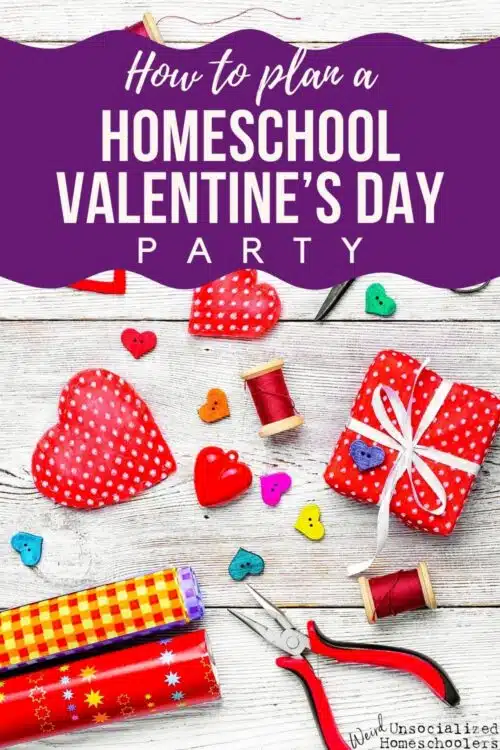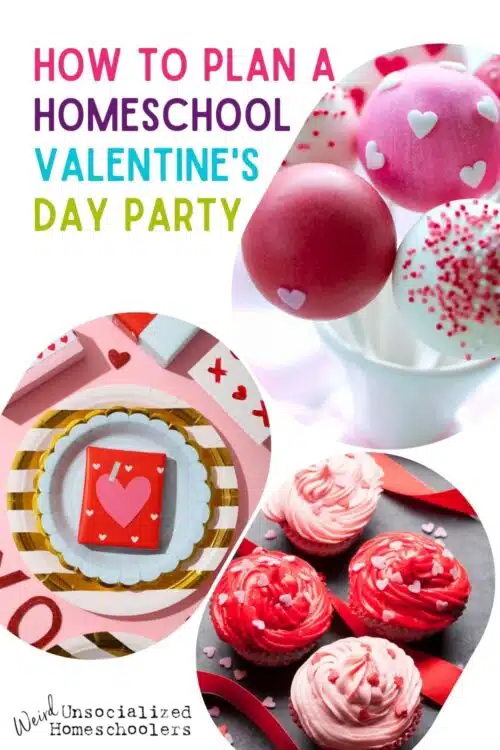How to Plan a Homeschool Valentine’s Day Party
I know Valentine’s Day is nearly a month away, but if you’re anything like me – a procrastinator – and you want to plan a party for your homeschool group or a small group of friends, consider this a friendly reminder to start thinking about it now. I usually start thinking about it around February 7. I don’t recommend that approach.
We haven’t done a homeschool Valentine’s Day party in several years, but when my kids were younger, they used to love our annual gathering, which started with just a small group of friends and grew larger each year. I was the official Valentine’s party planner for several years, so I’m happy to share my tips on how to plan a homeschool Valentine’s Day party.

How to Plan a Homeschool Valentine’s Day Party
1: Find a Location
First, you want to overcome the biggest obstacle for most homeschool groups – find a place. We live in the Bible Belt, so a church gym or fellowship hall was always our go-to place. Some other options to consider are:
- The meeting room at your local library
- A rec center
- A voting precinct/community meeting hall
- The home of the bravest homeschool mom in your group
Two of the most important factors to consider are tables and space. You’ll need a fair amount of both, depending on your group’s size.

2: Plan the Agenda
In my experience, there are three highlights of a Valentine’s Day party: food, games, and bag decorating.
Homeschool Valentine’s Day Party Food
For the food, you have a couple of options. You can either ask everyone to sign up for a dish or two and have a pot-luck-style event or ask everyone to chip in on pizza. The easiest option is probably pizza.
In addition, ask moms to volunteer to bring iced but undecorated cupcakes and/or cookies and sprinkles – because a cupcake decorating station is fun, y’all. Chips, candy, and other assorted hyperactivity-inducing treats are always well-received, too (by the kids, not necessarily their parents, but, hey, it’s a party).

photo credit Stuart webster on flickr
Homeschool Valentine’s Day Party Games
The kids in our homeschool group always enjoyed playing the kinds of group games that are hard to play without a decent-sized group. They loved games like Red Rover and What Time Is It, Mr. Fox?
If you’ve got teens and tweens, they may enjoy some board games. Chameleon is a fun one. And Poetry for Neanderthals is guaranteed to get some laughs! But what they’ll probably appreciate most is just some space to hang out and talk.
We were fortunate for a couple of years to have some space for the teens to hang out separately from the younger kids. They weren’t interested in exchanging Valentines or playing games, but no one complained about eating pizza and cupcakes while catching up with friends.
V-Day Bag Decorating
The kids in our group always enjoyed decorating bags for the homeschool Valentine’s Day party exchange. We’d ask everyone to bring a white or brown paper lunch sack for decorating. It would probably be just as easy for one or two moms to volunteer to bring bags for everyone.
If you start shopping early, you may be able to find a reasonable price on white or brown paper gift bags with handles. Those make excellent Valentine’s bags.
Ask the moms to sign up to bring things such as:
- stickers
- Magic markers and/or crayons
- foam stickers
Be sure to ask the moms not to bring glitter or glitter glue. Trust me on this.
Each child will decorate his or her own bag for the Valentine exchange. For the preschool through elementary-aged kids, this was always one of the highlights of our homeschool Valentine’s Day parties. Just remind everyone to put their name on their bag.
The Valentine Exchange
You’ll want to have a pretty good idea of how many kids will be attending before the party day so that all the kids can make sure they have enough Valentines to exchange. If you’re going to have a large number of children, it’s a good idea to split them into age groups for the Valentine exchange. (It can get pricey to buy 60-70 Valentines for each child in your family to exchange.)
Our group found that the easiest way to do the actual exchange was to write “my friend” in the “to” field and have each child sign their name in the “from” field. Before switching to that method, we used to gather a list of names before the party so that each of the kids could address their Valentine to a specific friend. That’s entirely up to you. It can be time-consuming and tedious to try to find each child’s bag, though, when cards are addressed to a particular person.
Once the bags are decorated, you can leave them on the tables so the kids can deliver their Valentines. However, we found the least confusing method to be to line the bags up around the perimeter of the room and let the kids go around, dropping their Valentines in each bag. This eliminated the confusion of kids trying to remember who they’d given a card to – but it would not be the best method if kids are going to be writing specific names on their cards.
Free Play
Finally, you want to make sure to allow plenty of time for free play. As sick as we homeschool parents may get about hearing the socialization argument, our kids do enjoy socializing with their friends. So don’t make the mistake of hosting a super-structured Valentine’s Day party. Give the kids a chance to just run and play. The bonus is that it gives you a chance to just sit down and chat with other adults. You’re welcome.
Have you ever hosted a homeschool Valentine’s Day party for your homeschool group or a group of your kids’ friends? What planning tips or activity ideas would you add?
You Might Also Be Interested In:
Two Weeks of Valentines for Couples
Quick and Easy Kid-Made Valentine’s Day Banner
Featured Image Photo by Ron Lach
Wendy is one of the owners of Hip Homeschool Moms, Only Passionate Curiosity, Homeschool Road Trips, Love These Recipes, and Weird, Unsocialized Homeschoolers. She married her high school sweetheart, Scott, 31 years ago, and they live in the South. They have three adult children. Hannah, age 27, has autism and was the first homeschool graduate in the family. Noah, age 25, was the second homeschool graduate and the first to leave the nest. Mary Grace, age 19, was the last homeschool graduate. Wendy loves working out and teaching Training for Warriors classes at her local gym. She also enjoys learning along with her family, educational travel, reading, and writing, and she attempts to grow a garden every summer with limited success. (But she's learning!)












I am so glad that I found you via Simple Homeschool. You are a breath of fresh air and I feel more comfortable with your approaches at life than some others that seem stricter.
I unschool and follow our state’s standards of learning (just to make sure basics are being met). We use workbooks or printed worksheets as our general practice but then I try to get her to commit to a project of her choosing to make sure she understands what we are learning. Mine is only seven and I only have one but so far this works for us.
Glad I found you!
Oh, my daughter would LOVE this! Thanks for the idea!